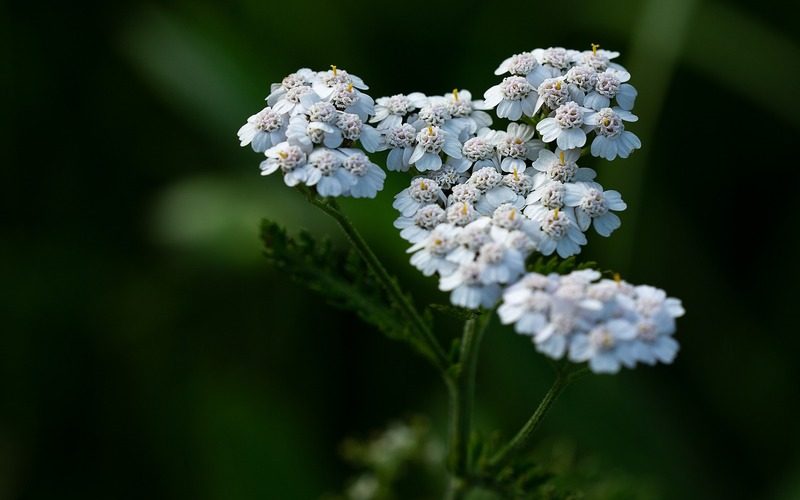Unveiling the Health Benefits of Yarroway: Nature’s Wellness Secret!
Yarrow, also recognized as Achillea millefolium, is steeped in historical significance and folklore while offering a range of health benefits. This flowering plant was historically carried by warriors into battle to utilize its healing properties, a practice that has continued for centuries.
Presently, it’s not only the tales that captivate but also the health benefits of the plant, attracting those interested in natural healing solutions.
Yarrow is visually appealing with its fine, feather-like foliage and small, white floral clusters, believed to be as effective in health as it is appealing.
A vibrant field of yarroway with bees gathering nectar under the sunlight, accentuating the delicate white blossoms and feathery green leaves. Yarrow is reputed to possess multiple health advantages, traditionally used to accelerate wound healing and celebrated for its purported anti-inflammatory properties.
People often turn to yarrow for potential relief from digestive issues and to aid in blood pressure regulation.
Exploring deeper into the usage of yarrow, there is a clear link between this herb and its potential effects on health, ranging from physical benefits to the alleviation of anxiety.
Key Takeaways Yarrow is revered for its therapeutic benefits. It is employed in healing wounds, reducing inflammation, and managing blood pressure. It holds significance in both traditional medicine and contemporary natural health discussions. Historical Significance of Yarrow A field of yarrow plants among historical artifacts, symbolizing its importance in traditional medicine. Yarrow, or Achillea millefolium, has a storied past filled with myths and traditional uses dating back centuries. It’s more than just an attractive plant; it carries significant historical weight.
Yarrow in Mythology Linked to ancient myths, notably the Greek hero Achilles who reportedly used yarrow to heal his warriors’ wounds, the plant was named millefolium, meaning ‘a thousand leaves’, referencing its densely feathered leaves.
Historical Medicinal Uses Yarrow was a staple healer across continents, from North America to Europe, where it was trusted for a variety of ailments. Its leaves and flowers were made into teas and salves for treating colds and wounds, demonstrating its widespread historical use.
Botanical Profile
Known as Achillea millefolium, yarrow is distinguishable by its appearance and widespread habitat. Here’s a closer look at the plant.
Defining Characteristics Yarrow is a resilient perennial with fern-like leaves, adding a delicate touch to its structure.
In summer, it produces a flat cluster of flowers, typically white, though they can also appear pink or yellow.
Yarrow’s Habitat This robust herb is found across temperate regions of the Northern Hemisphere, including Europe, Asia, and North America.
It commonly grows in fields, forests, and sunny roadside spots, thriving in both wild and cultivated gardens.
Health Benefits of Yarrow
Yarrow offers extensive health benefits, from promoting skin health to aiding digestion and addressing women’s health issues. Here’s how it contributes in these areas.
Skin Health Yarrow is recognized for soothing skin irritations and promoting wound healing, with research supporting its use in topical applications.
Digestive Aid Yarrow helps alleviate digestive discomfort by relaxing gastrointestinal muscles and can also reduce fever by promoting sweating.
Women’s Health Yarrow provides relief during menstruation by easing cramps and has historically been used to treat various female health conditions.
Preparation and Usage
Yarroway can be enjoyed as a herbal tea or used in topical remedies. Here’s how to prepare it for various health benefits.
Making Yarrow Tea To prepare Yarrow tea, add a tablespoon of dried Yarrow flowers to boiling water, steep for 10-15 minutes, strain, and enjoy. This tea is beneficial for colds and digestion.
Tinctures and Ointments For tinctures, soak Yarrow in high-proof alcohol, strain after several weeks, and use orally. For ointments, infuse Yarrow in oil, mix with beeswax, and apply topically for wound healing.
Potential Side Effects and Precautions Before using Yarroway, be aware of possible side effects and necessary precautions.
General Cautions While beneficial, Yarroway can cause skin irritation or increased urination in some individuals.
Specific Risks Those with allergies, particularly to ragweed, or who are pregnant or breastfeeding should consult a doctor before use. Additionally, discuss with a doctor if using antiseptics to ensure compatibility.
Nutritional and Chemical Compounds Yarroway is rich in antioxidants, anti-inflammatory compounds, and essential oils, contributing to its health benefits.
Culinary Uses Yarrow adds a unique, slightly bitter flavor to dishes and can be used in homemade alcoholic beverages for an earthy taste.
Ecological Impact
Yarrow plays a crucial role in its ecosystem, supporting soil stability and providing a nutrient-rich environment for neighboring plants and a nectar source for insects.
Frequently Asked Questions
Detailed answers to common questions about yarrow’s impact on skin health, menstrual relief, emotional well-being, daily usage safety, and traditional medicinal uses of yarrow root.
